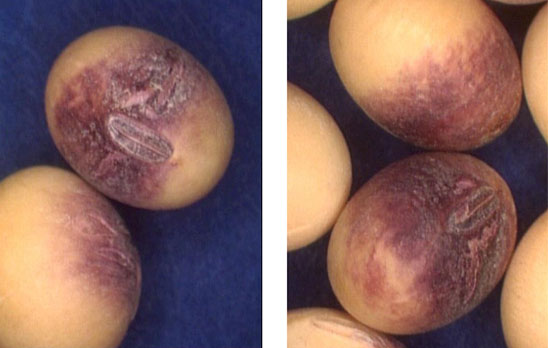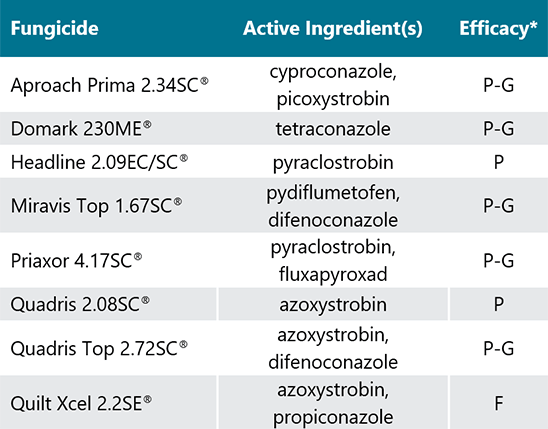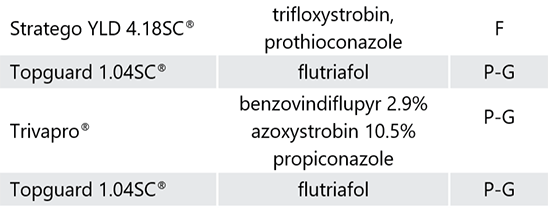Disease Facts
- Caused by a fungal pathogen, Cercospora kikuchii.
- Infection is favored by humid conditions and temperatures of 75 to 80 °F or higher.
- Can be found throughout the U.S. and Canada. Disease is becoming more common in the midwestern U.S.
- Generally occurs during pod-filling stages (August), affecting both leaves and seeds of soybeans.
Disease Development
- Disease organism survives as mycelia on soybean residue and on the seed coat of infected seed.
- Sporulation occurs under conditions of high humidity and temperatures of 75 ºF or higher. Sporulation increases as temperatures rise above 80 ºF.
- Spores carried by wind and water infect leaves and stems. Infection may remain latent until favorable conditions develop during soybean pod-fill stages.
- Lesions develop on leaves during hot, humid conditions. Sporulation from lesions results in secondary infections.
- Seeds become infected when the fungus invades the pod and grows through the upper vein. The hilum and eventually the seed coat become infected.
- Infected plants and seeds provide inoculum for the
next soybean crop.

Figure 1. Leaf symptoms of Cercospora kikuchii, which causes purple seed stain of soybean seeds. Leaf symptoms begin as a light purple color that extends over the leaf and develops a leathery appearance.
Disease Symptoms - Leaf Blight
- The Cercospora leaf blight phase generally begins in August at the start of pod fill on late-planted soybeans.
- Sun-exposed leaves on the upper part of the plant develop a reddish-purple to bronze discoloration (Figure 1).
- Discoloration results from numerous irregular-shaped lesions that range from small specks to half-inch spots, and may extend to the upper stems, petioles and pods.
- Lesions form large necrotic blotches as the disease progresses and lesions merge.
- As plants mature, infected leaves develop a leathery appearance.
- Severely affected upper leaves may drop but the petioles remain on the plant; lower leaves of the plant remain green and attached (Figure 2).
- Infection sites on petioles and stems are sunken red lesions that can be up to ¼ inch in length.

Figure 2. Field infected with cercospora leaf blight of soybeans. The pathogen overwinters on infested debris or seed.
Impact on Crop
- Plants infected early from diseased seed may lose their cotyledons, become stunted, or die.
- Loss of leaf tissue or entire leaves may occur. Extensive blighting of fields is common with severe infections.
- Defoliation may reduce yield if disease occurs early relative to pod fill. Significant yield loss is more common in southern states than in northern and central states.
- Purple seed stain may reduce quality and marketability of soybeans. Severely stained seed may be docked at the elevator, depending on percent of seed affected.
Symptoms - Purple Seed Stain
- Lesions and a purplish discoloration are symptoms of infected pods. Seeds are infected through their attachment to the pod, the hilum (Figure 3).
- Infected seeds may show a pink or pale to dark-purple discoloration, which varies in size from specks to blotches that cover the entire seed coat.
- Seed discoloration extends from the seed hilum in all cases. However, seed is sometimes infected without showing obvious symptoms.

Figure 3. Close-up of soybean seeds with purple seed stain, caused by a fungal disease, Cercospora kikuchii. Infected seeds have a pink-to-purple discoloration on their seed coats.
Disease Management
Rotation and Tillage
- A one- to two-year rotation to corn or small grains will reduce inoculum levels. Other legumes should not be included in the rotation.
- Tillage, where practical, can be used to incorporate and hasten the decomposition of crop residue on which Cercospora pathogens survive.
Genetic Resistance
- Soybean varieties vary in their response to Cercospora, but a high level of resistance is not currently available. Nevertheless, many commercial varieties demonstrate at least some degree of tolerance.
- Resistance to the leaf blight and seed infection stages are thought to be under different genetic control.
Seed Treatments
- The fungicide component of seed treatments can help protect against early infection of seedlings that may result in cotyledons shriveling, turning dark purple and dropping early or plants that die or become stunted.
Fungicides
- Many commonly used foliar fungicides are labeled for Cercospora leaf blight on soybeans; however research has shown efficacy to often be variable (Table 1).
- Single applications at R2 to R4 (full-flower to full-pod stages) tend to perform better in reducing the leaf blight phase of this disease than applications made at the R5 (beginning-seed) stage.
- Single applications at R4 to R5 (full-pod to beginning-seed stages) can reduce the incidence of purple seed stain, but may or may not improve soybean yield.
- The cost-effectiveness of multiple applications has not been proven.
Table 1. Efficacy of select foliar fungicides for control of Cercospora leaf blight (Smith, 2020).


* E=Excellent; VG=Very Good; G=Good; F=Fair; P=Poor
References
- Anonymous. 2010. Soybean Diseases - Pub. CSI 0004. Iowa Soybean Association and Iowa State University.
- Hershman, D. 2009. Cercospora leaf blight in Kentucky. Plant Pathology Fact Sheet PPFS-AG-S-20. University of Kentucky Cooperative Extension Service.
- Smith, K.L. 2020. Fungicide Efficacy for Control of Soybean Foliar Diseases. Crop Protection Network. CPN-1019-W.
The foregoing is provided for informational use only. Please contact your Pioneer sales professional for information and suggestions specific to your operation. Product performance is variable and depends on many factors such as moisture and heat stress, soil type, management practices and environmental stress as well as disease and pest pressures. Individual results may vary.